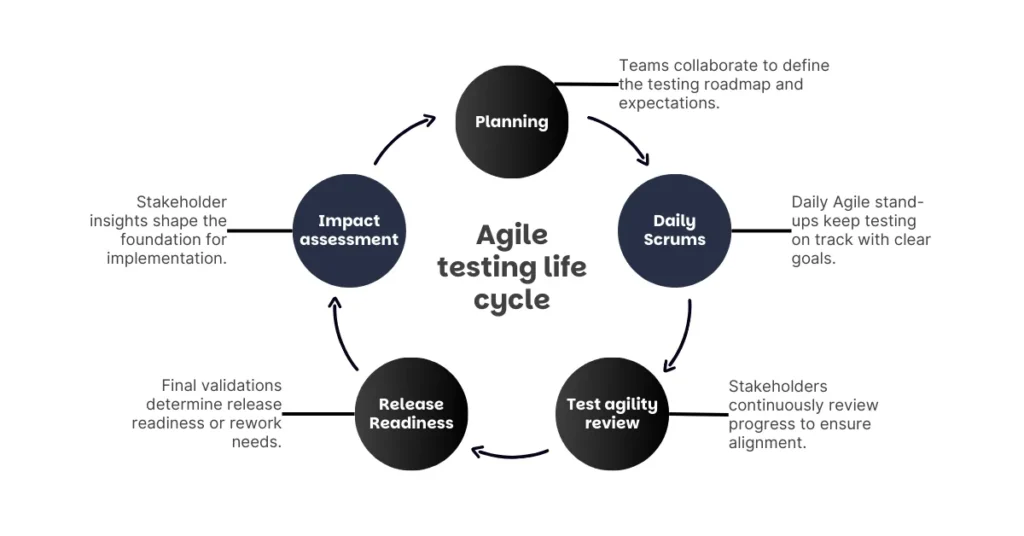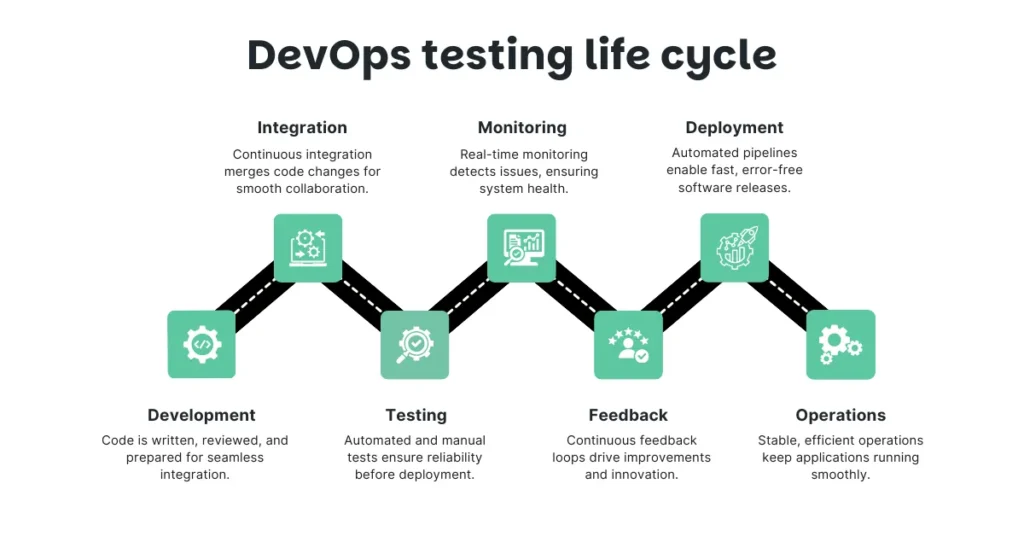Software development has come a long way from traditional Waterfall methodologies involving linear sequencing to more dynamic and efficient Agile and DevOps approaches providing continuous feedback. This shift has transformed software testing, making it faster, more collaborative, and integral to the development process. In this blog, we will explore the significance of Agile and DevOps in software testing and their ability to deliver high quality with efficiency.
What is Agile?
Agile is a software development methodology that emphasizes iterative development, collaboration, and adaptability. It follows principles such as:
- Responding to change over following a fixed plan
- Maintaining simplicity with face-to-face communication
- Continuous improvement and highest-quality delivery
Agile enables teams to develop software in short cycles, known as sprints, ensuring that feedback is incorporated early and frequently.
What is DevOps?
DevOps is a cultural and technical movement that bridges the gap between development and operations teams. It integrates continuous integration (CI) and continuous delivery (CD) to automate and streamline software development and deployment with collaboration, fast feedback, and iterative improvement. Core principles of DevOps include:
- Collaboration and communication
- Automation of software deployment lifecycle
- Continuous improvement, minimization of waste with short feedback loops
Organizations can accelerate software delivery while maintaining stability and reliability with DevOps Implementation.

The Role of Agile in Software Testing
Agile has revolutionized software testing by integrating it throughout the development lifecycle. Unlike traditional methodologies where testing occurs at the end, Agile ensures testing is continuous and iterative.
Shift from Waterfall to Iterative Testing
Traditional Waterfall methodologies relied on linear sequential development, with testing occurring only after the development phase. This often led to late-stage defect detection, causing delays and rework. Agile replaces this approach with iterative testing, where testing happens simultaneously with development, enabling early issue detection and resolution.
Continuous Feedback Loops
Agile promotes frequent feedback through daily stand-ups, sprint reviews, and retrospectives. This ensures that defects are identified and resolved early, reducing the risk of major issues in later stages.
Early Involvement of QA in Agile Teams
Agile encourages QA professionals to be involved from the beginning of the project. By participating in requirement discussions, QA teams can ensure that testing aligns with customer expectations and business objectives.
Test Automation in Agile
Test automation plays a crucial role in Agile. With short development cycles, manual testing alone is insufficient. Automated testing helps validate new features, ensuring regression testing, and improving overall efficiency.

The Role of DevOps in Software Testing
DevOps extends Agile principles by integrating testing into CI/CD pipelines, ensuring that testing is continuous and automated.
Continuous Testing in DevOps
Continuous testing is a key DevOps practice in which automated tests are executed at every stage of development. This helps in identifying defects early and ensures software stability throughout the pipeline.
Test Automation in CI/CD Pipelines
DevOps relies heavily on automated testing within CI/CD pipelines. Automated unit tests, integration tests, and end-to-end tests ensure that code changes are thoroughly validated before deployment.
Shift-Left Testing in DevOps
The “Shift-Left” approach in DevOps moves testing earlier in the development process. By detecting defects early, teams can prevent costly rework and maintain high software quality.
Collaboration Between QA, Development, and Operations
DevOps fosters a culture where QA, developers, and operations work together. This collaboration ensures that testing is a shared responsibility rather than a bottleneck.
Key Benefits of Agile and DevOps in Testing
Faster Time to Market:
Agile and DevOps streamline development and testing, enabling faster releases and quicker response to market demands.
Early Defect Detection and Resolution:
By integrating testing early, defects are identified sooner, reducing costly rework and enhancing software reliability.
Improved Collaboration and Communication:
Agile and DevOps promote teamwork between developers, testers, and operations, ensuring better alignment and smoother workflows.
Enhanced Software Quality and Reliability:
Continuous testing and automation ensure that software is tested thoroughly, leading to higher quality and reliability.
Implementing Agile and DevOps in Testing: Best Practices
Automating Repetitive Tests
Automating repetitive tests saves time and reduces manual errors, making Agile sprints and DevOps pipelines more efficient.
Integrating Testing into the Development Pipeline
Embedding automated tests in the CI/CD pipeline ensures that code changes are validated continuously, preventing defects from reaching production.
Encouraging a Collaborative Culture
A strong collaborative culture ensures that testing is not isolated but an integral part of development and operations.
Adopting a Test-First Approach
Practices like Test-Driven Development (TDD) and Behavior-Driven Development (BDD) ensure that testing is a priority, improving software quality.
Challenges of Agile and DevOps in Testing
Maintaining Automation at Scale:
Scaling test automation requires robust infrastructure and efficient test management to avoid bottlenecks.
Balancing Speed and Quality:
Fast releases can sometimes compromise quality. Finding the right balance between speed and thorough testing is crucial.
Managing Technical Debt:
Frequent releases may introduce technical debt. Regular refactoring and code reviews help in managing long-term code quality.
Future Trends: Agile, DevOps, and the Evolution of Testing
AI and Machine Learning in Testing:
AI-driven test automation is improving test coverage, identifying defects faster, and optimizing testing efforts.
Increased Focus on Security Testing (DevSecOps):
Security is becoming a priority in DevOps, integrating security testing (DevSecOps) into the CI/CD pipeline.
Continuous Testing Beyond CI/CD:
Testing is expanding beyond CI/CD to cover production monitoring, user feedback analysis, and continuous improvement.
Final Thoughts
Agile and DevOps have transformed software testing, making it more iterative, automated, and collaborative. “When done right, Agile and DevOps enhance software quality without slowing down delivery.” If you’re looking to integrate Agile and DevOps into your testing process, QA Touch can help streamline your efforts. Contact us today to learn more!







